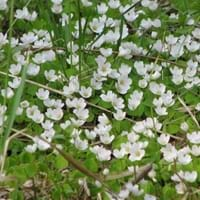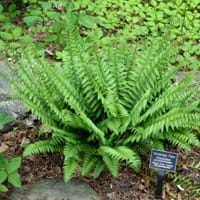Life Span
Perennial
Perennial
Origin
World, Pandemic, North America, Europe, United Kingdom, Asia
North America, Northeastern United States
Types
Not available
Not Available
Habitat
Shaded sites, Woodlands
Boggy areas, By seashore, Coastal Regions, Moist woods, Swamps
USDA Hardiness Zone
3-8
3-8
Sunset Zone
A3, 1a, 1b, 2a, 2b, 3a, 3b, 4, 5, 6, 7, 8, 9, 10, 14, 15, 16, 17, 18, 19, 20, 21, 22, 23, 24
1a, 1b, 2a, 2b, 3a, 3b, 4, 5, 6, 8, 9, 14, 15, 16, 17, 18, 19, 20, 21, 22, 23, 24
Habit
Mat-forming
Clump-Forming
Flower Color
White, Light Pink
Not Available
Flower Color Modifier
Bicolor
Bicolor
Fruit Color
Not Available
Not Available
Leaf Color in Spring
Light Green
Green
Leaf Color in Summer
Light Green
Green, Dark Green
Leaf Color in Fall
Light Green
Green, Dark Green
Leaf Color in Winter
Light Green
Dark Green
Leaf Shape
Heart-shaped
Pinnate
Plant Season
Spring, Summer, Fall
Spring, Summer, Fall, Winter
Sunlight
Partial Sun, Partial shade, Full Shade
Full Sun, Partial shade
Type of Soil
Clay, Loam, Sand
Loam
The pH of Soil
Neutral
Acidic, Neutral
Soil Drainage
Average
Average
Bloom Time
Spring
Indeterminate
Tolerances
Shade areas
Drought, Wet Site
Where to Plant?
Ground
Container, Ground
How to Plant?
Divison, Seedlings
Divison, Spores
Plant Maintenance
Low
Medium
Watering Requirements
Water in the early morning hours
Requires a lot of watering, Requires regular watering, Requires watering in the growing season, Water Deeply
In Summer
Lots of watering
Lots of watering
In Spring
Moderate
Moderate
In Winter
Average Water
Average Water
Soil pH
Neutral
Acidic, Neutral
Soil Type
Clay, Loam, Sand
Loam
Soil Drainage Capacity
Average
Average
Sun Exposure
Partial Sun, Partial shade, Full Shade
Full Sun, Partial shade
Pruning
Remove damaged leaves, Remove dead branches, Remove dead flowers, Remove dead leaves
Remove damaged leaves, Remove dead branches, Remove dead leaves
Fertilizers
All-Purpose Liquid Fertilizer
All-Purpose Liquid Fertilizer
Pests and Diseases
Aphids, Root rot, Whiteflies
Red blotch
Plant Tolerance
Shade areas
Drought
Flower Petal Number
Single
Single
Foliage Texture
Medium
Medium
Foliage Sheen
Matte
Matte
Allergy
Asthma, Depression
Avoid during Pregnancy, coma, Eye irritation, weakness
Aesthetic Uses
Not Used For Aesthetic Purpose
Beautification, Landscape Designing, Showy Purposes
Beauty Benefits
Good for skin, Not Available
Not Available
Environmental Uses
Air purification
Air purification
Medicinal Uses
Digestive, Eye Problems, Vitamin A, Vitamin C
Nutrients
Part of Plant Used
Flowers, Leaves
Leaves
Other Uses
Cleanser
Air freshner, Decoration Purposes, Employed in herbal medicine, Showy Purposes, Used for its medicinal properties
Used As Indoor Plant
No
Yes
Used As Outdoor Plant
Yes
Yes
Garden Design
Container, Mixed Border, Wildflower
Groundcover, Mixed Border, Rock Garden, Wall
Botanical Name
OXALIS acetosella
POLYSTICHUM acrostichoides
Common Name
wood sorrel, common wood sorrel
Not Available
In Hindi
Wood Sorrel
Christmas Fern
In German
Sauerklee
Christmas Fern
In French
bois Sorrel
polystic faux-acrostic
In Spanish
alazán de madera
Christmas Fern
In Greek
ξύλο Sorrel
Christmas Fern
In Portuguese
Sorrel de madeira
Christmas Fern
In Polish
Drewno szczaw
Christmas Fern
In Latin
Rumex ligno
Christmas Fern
Phylum
Magnoliophyta
Filicinophyta
Class
Magnoliopsida
Filicopsida
Order
Oxalidales
Filicales
Family
Oxalidaceae
Dryopteridaceae
Clade
Angiosperms, Eudicots, Rosids
Not Available
Tribe
Not Available
Not Available
Subfamily
Not Available
Not Available
Number of Species
Not Available
Season and Care of Wood Sorrel and Christmas Fern
Season and care of Wood Sorrel and Christmas Fern is important to know. While considering everything about Wood Sorrel and Christmas Fern Care, growing season is an essential factor. Wood Sorrel season is Spring, Summer and Fall and Christmas Fern season is Spring, Summer and Fall. The type of soil for Wood Sorrel is Clay, Loam, Sand and for Christmas Fern is Loam while the PH of soil for Wood Sorrel is Neutral and for Christmas Fern is Acidic, Neutral.
Wood Sorrel and Christmas Fern Physical Information
Wood Sorrel and Christmas Fern physical information is very important for comparison. Wood Sorrel height is 5.10 cm and width 30.00 cm whereas Christmas Fern height is 30.50 cm and width 45.70 cm. The color specification of Wood Sorrel and Christmas Fern are as follows:
Wood Sorrel flower color: White and Light Pink
Wood Sorrel leaf color: Light Green
Christmas Fern flower color: Not Available
- Christmas Fern leaf color: Green
Care of Wood Sorrel and Christmas Fern
Care of Wood Sorrel and Christmas Fern include pruning, fertilizers, watering etc. Wood Sorrel pruning is done Remove damaged leaves, Remove dead branches, Remove dead flowers and Remove dead leaves and Christmas Fern pruning is done Remove damaged leaves, Remove dead branches and Remove dead leaves. In summer Wood Sorrel needs Lots of watering and in winter, it needs Average Water. Whereas, in summer Christmas Fern needs Lots of watering and in winter, it needs Average Water.





